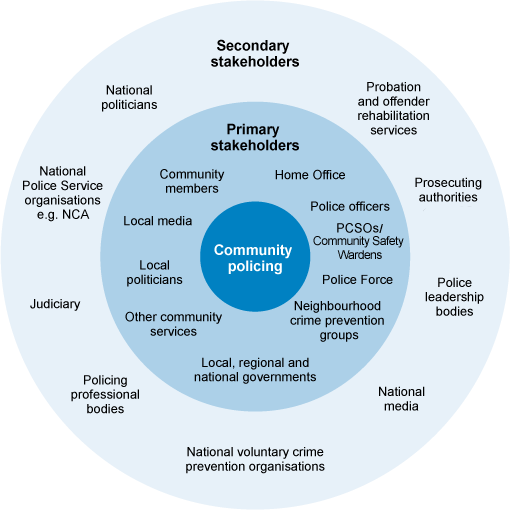2.2 Stakeholders in community policing
Policing is example of a community service with a complex range of stakeholders. Take a look at Figure 3. These are just some of the stakeholders we can identify in community policing
The inner ring of the diagram – directly circling community policing – depicts the primary stakeholders. These are individuals and groups that have a direct, specific interest in how community policing is run, its mission, its effectiveness and other day-to-day issues.
The outer area depicts the secondary stakeholders, who may also have an interest in the community policing but perhaps not as directly or as specifically as those in the inner circle. Of course, secondary stakeholders can also take a direct interest – for example, in the case of inter-service partnerships, the partners will want to ensure that partnership commitments are being upheld by the police force in question.
Watch this video of Ben Hargreaves, a Chief Inspector in Dorset Police, talking about the work of neighbourhood advisory groups in community policing. Where do you think these groups will fit on Figure 4 above.

Transcript
Activity 4 Mapping your stakeholders
In your learning journal, make a list of the primary and secondary stakeholders of a community activity, project or organisation with which you are familiar. This can be any aspect of the community where you live, work or volunteer.
You might like to create a stakeholder diagram, similar to Figure 4 to depict the stakeholders you identify. Your diagram will have your chosen activity, project or organisation in the centre.
What similarities and differences with the case example did you note and why?
Discussion
You probably found both similarities and differences – depending on the size of the activity you chose, as well as what field it is in (e.g. health and social care, environmental, hobby or sports and so on). You might also have found that Figure 4 made you think more widely about the people who might have an interest in your community.
This activity will have helped you think about who the stakeholders are in the context of community safety. We will return to the theme of how to work and communicate with community stakeholders later in this course. For now though it is time to look at a different model of relationships which both contrasts with and complements the stakeholder model.

